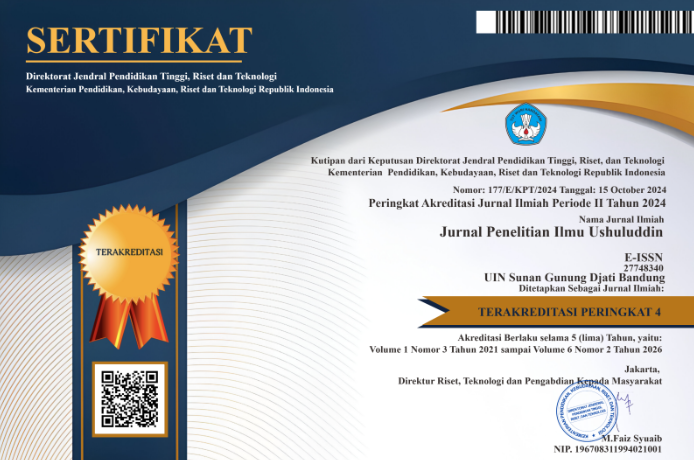Diskursus tentang Kebolehan Jamak Salat dalam Hadis Perspektif Sunni dan Syiah
DOI:
https://doi.org/10.15575/jpiu.41345Keywords:
Hadith, Jamak Prayer, Shia, SunniAbstract
This article discusses the comparison of the permissibility of combining prayers according to the hadith from the perspective of Sunni and Shia, two major schools of thought in Islam. This study aims to discuss the hadith basis that underpins the practice of combining prayers, both in emergency situations and outside of emergency situations, according to the interpretations of both sects.The method used is qualitative analysis through literature review, such as hadith books, books containing the views of prominent scholars from each school of thought, articles and related scientific works. The research results show that the Sunni school generally permits combining prayers under certain conditions such as travel, rain, or emergencies, based on hadiths narratedÄ by the Prophet's companions. Meanwhile, the Shia school of thought is more flexible in allowing combining prayers, not limited to emergency conditions, based on the traditions of the Infallible Imams. This comprehensive research reveals that the differences in perspective are rooted in the methodological approaches to hadis interpretation and the mechanisms of authority legitimation in legal determination.References
Abu Ja’far, & Al-Kulaini, M. bin Y. (1949). Ushul al-Kafi (Vol. 3). Tehran: Dar al- Kutub al-Islamiyah.
Al-Bukhari, M. ibn I. A. A. (2001a). Shahih al-Bukhari (Vol. 2). Dar Tauq al-Najah.
Al-Bukhari, M. ibn I. A. A. (2001b). Shahih Bukhari (Vol. 1). Dar Tauq al-Najah.
Al-Majalisi, M. B. (1986). Miladh al-Akhyar fi Fahm Tahdhib al-Akhbar (Vol. 4). Qom: Maktabat Ä€yat AllÄh al-’Uẓmá al-Mar’ashÄ« al-NajafÄ« al-Kubrá.
Al-Mizzi, J. A. al-H. Y. (1987). Tahdzibul Kamal fi Asma’ al-Rijal. Beirut: Muassasah al-Risalah.
Al-Mualim, al-S. H. S. (1963). Muntaqa al-Juman fi al-Ahadith al-Sihah wa al-Hisan (Vol. 1).
Al-Tusi, A.-S. (2005). Tahdzib al-Ahkam (Vol. 3). Khurosan: Ansyariyan Publication.
Amaliyah, E. I. (2015). Harmoni Di Banjaran: Interaksi Sunni-Syiah. Harmoni, 14(2).
Anas, M. bin. (1985). Muwata’ Imam Malik (Vol. 1). Beirut: Dar Ihya’ al-Turats al-’Arabi.
Anwar, S., Fauzi, M., Yani, A., & Siswoyo. (2023). Toleransi Dalam Pandangan Imam Mazhab Dan Ulama Kontemporer Perspektif Hukum Islam. Hutanasyah: Jurnal Hukum Tata Negara (Siyasah Syar’iyyah), 1(1).
Arif Agung Nugroho. (2011). Jamak Shalat Menurut Imam Syafi’i dan Imam Ja’far. UIN Sunan Kalijaga.
Arifin, N. F. (2023). Interaksi Sosial Syiah Dan Sunni Di Jember 2000-2023. Jurnal Sandhyakala, 4(2).
Arisman. (2014). Jamak Dan Qadha Shalat Bagi Pengantin Kajian Fiqh Kontemporer. Hukum Islam, 14(1).
Asrori, M. (2024). Salat Jamak Tanpa Uzur (Studi Komparasi Pemikiran Yusuf Al-Qaradawi Dan Muhammad Hasbi Ash-Shiddieqy). UIN Sunan Kalijaga Yogyakarta.
Asy-Syaikh, S. bin A. A. A. (2015). Al-Fiqh Al-Muyassar. Jakarta: Darul Haq.
Awal, S. (1934). Dzikr al-Syiah fi Ahkam al-Syari’ah (Vol. 2). Qom: Muassasah Ali al-Bait ’alaihim al-Salam.
Awaliyah, R. (2018). Pemahaman Hadis Menjamak Salat Tanpa Uzur. UIN Syarif Hidayatullah Jakarta.
Chandra, H., Alwi, Z., Ghozali, R. I., & Irwanto, M. (2021). Pengaruh Politik Sunni dan Syiah Terhadap Perkembangan Ilmu Hadis. Depok: Rajawali Pres.
Devi, A. D. (2020). Studi Kritik Matan Hadis. Al-Dzikra, 14(2).
Devi, A. D., & Andrean, S. (2021). Tinjauan Hadist Dalam Perspektif Sunni Dan Syi’ah. Tahdis, 12(1).
Dewi, M. S. (2022). Analisis Waktu Salat Fardu Ijtihad Ulama Sunni Dan Syiah Perspektif Astronomi. UIN Walisongo Semarang.
Fadillah, N. H., Kusuma, A. R., & Anwar, R. (2022). Comparative Study of Ijtihad Methods Between Ahlussunnah and Syi’ah. Tasfiyah, 6(1).
Fajar, M., Ilyas, M., & Ghafir, A. A. S. Al. (2024). Madzhab Fiqih Di Indonesia: Konstruksi Moderasi Beragama Dalam Perbedaan Pendapat Dan Aliran. Majemuk, 1(2).
Faruq, U. Al, Az-Zahra, M., R.F, M. F., & Aqil, I. (2024). Pengaruh Perbedaan Pendapat Ulama Terhadap Tasyri’. Tasdiq, 4(3).
Hatta, J. (2023). Paradigma Transintegritas Ilmu:Mendekati Islam dari Sisi Sosiologi Islam. Journal of Applied Transintegration Paradigm, 3(1).
Ihsan, S. F., Wendry, N., Suhaili, H., & Kurnia, A. (2024). Komparasi Epistemologi Hadis Sunni dan Syiah: Pendekatan Validitas dan Otoritas di Tengah Tantangan Modernitas. Mauriduna, 5(2).
Iqbal, M. (2017). Jamak dan Qasar Salat dalam Islam: Telaah terhadap Pemikiran M. Hasbi Ash-Shiddieqy. Tafse, 2(2).
Juliana, R. (2017). Hukum Menjama’ Dan Mengqasar Shalat (Studi Perbandingan Mażhab Hanafi dan Mażhab Syafi’i). Universitas Islam Negeri Ar-Raniry Darussalam.
Ma’u, D. H. (2015). WAKTU SALAT: Pemaknaan Syar’i Ke Dalam Kaidah Astronomi. Istinbath, 14(2).
Mayunda, U. L., & Marpaung, A. (2022). Menjamak Sholat Bagi Pengantin yang Melaksanakan Walimah Al ’Urs Perspektif Syekh Alwi Ahmad Saqqaf dan Imam Asy-Syaukani. Al-Manhaj, 4(2).
Muslim ibn al-Hajjaj. (1955a). Shahih Muslim (Vol. 1). Beirut: Dar Ihya’ al-Turats al-’Arabi.
Muslim ibn al-Hajjaj. (1955b). Shahih Muslim (Vol. 2). Beirut: Dar Ihya’ al-Turats al-’Arabi.
Muslimah, S., & Abidin, S. (2019). Studi Komparatif Menurut Imam Hanafi Dan Imam Syafi’i Tentang Sholat Jamak Dan Qasar Bagi Musafir. Academia: Jurnal Ilmu Sosial Dan Humaniora, 2(1).
Nurdin, A., Komarudin, E., & Taufik, W. (2024). Analisis Thibaq dalam Surah al-Ahzab. Jurnal Penelitian Ilmu Ushuluddin, 4(3).
Pugu, M. R., Riyanto, S., & Haryadi, R. N. (2024). Metodologi Penelitian; Konsep, Strategi, dan Aplikasi. Jambi: PT. Sonpedia Publishing Indonesia.
Rahman, O., & Rahman, M. G. (2020). Tafsir Ideologi: Bias Idiologi dalam Tafsir Teologi Sunni, Muktazilah, dan Syiah. As-Syams: Journal Hukum Islam, 1(2).
Ria Ramadhani. (2024). Sholat Jamak Dan Qosor. Tashdiq, 7(2).
Rizal, M., Putra, R. S., Haq, N. N., & Al-Faruq, U. (2024). Pemahaman Shalat Jama’ Dan Qashar Dalam Islam. Jurnal Ilmiah Multidisiplin Terpadu, 8(12).
Said, M., & Zubair, M. (2024). Hakekat Pembelajaran Digital dalam Pendidikan Islam. Jurnal Ilmiah Profesi Pendidikan, 9(3).
SAKINAH, M. (2024). Hukum Mengqashar Shalat Dalam Safar (Analisis Perbandingan Pendapat Ibnu QudÄmah dan Al-NawawÄ« tentang Batasan Waktu dan Tempat). Uin Ar-Raniry Banda Aceh.
Shaduq, S. (1966). ’Ilal al-Syara’i (Vol. 2). Qom: Kitab Furusyi Dawari.
Siroj, A. M. (2019). Konsep Kemudahan Dalam Hukum Perspektif Al-Qur’an Dan Hadis. At-TurÄṡ: Jurnal Studi Keislaman, 6(2).
Sulaiman, S. (2017). Relasi Sunni-Syiah: Refleksi Kerukunan Umat Beragama di Bangsri Kabupaten Jepara. Panangkaran, 1(1).
Susanto, D., Risnita, & Jailani, M. S. (2023). Teknik Pemeriksaan Keabsahan Data Dalam Penelitian Ilmiah. Qosim, 1(1).
Tizaz Lusqis Salam. (2023). Penerapan Hukum Salat Jama’ Bagi Orang Yang Sakit Perspektif Syafi’iyah Dan Hanabilah. UIN Syarif Hidayatullah.
Umar, U. (2019). Pemikiran Politik Era Kenabian, Sahabat Dan Sekte-Sekte Islam: Tinjauan Sketsa Historisitas. Jurnal Mimbar, 5(2).
Yusrizal. (2018). Batas Waktu Musafir Bermukim untuk Kebolehan Qasar Shalat (Studi Perbandingan Mazhab Hanafi dan Mazhab Syafi’i). UIN Raniry.
Downloads
Published
Issue
Section
License
Authors who publish in Jurnal Penelitian Ilmu Ushuluddin agree to the following terms:
- Authors retain copyright and grant the journal right of first publication with the work simultaneously licensed under an Attribution-ShareAlike 4.0 International (CC BY-SA 4.0) License that allows others to share the work with an acknowledgment of the work's authorship and initial publication in this journal.
- Authors are able to enter into separate, additional contractual arrangements for the non-exclusive distribution of the journal's published version of the work (e.g., post it to an institutional repository or publish it in a book), with an acknowledgment of its initial publication in this journal.
- Authors are permitted and encouraged to post their work online (e.g., in institutional repositories or on their website) prior to and during the submission process, as it can lead to productive exchanges, as well as earlier and greater citation of published work (See The Effect of Open Access).












